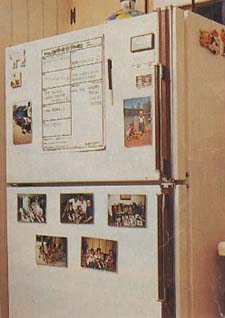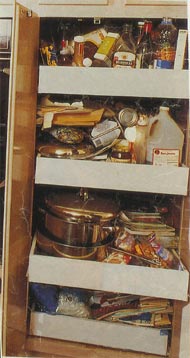
Case Study:
Kitchen Chaos and No Counter Space for Chopping
THE COMPLAINT
Martha Clark Ackermann has always had a roomy, well-equipped kitchen with plenty of cabinet, drawer, and counter space. Nevertheless, she often found herself chopping veggies on a board at the kitchen table, wasting time searching for pots and pans, and even buying things she knew she already owned. “I have three spring form pans that are identical,” she admits. “I could never find what I had, so I’d go out and buy a new one.”
Now and then, Martha would work up the courage to tackle two or three drawers or a few cabinets, but the effects of her cleaning and neatening never lasted. It was a frustrating cycle, especially for Martha, who considers herself fairly organized. For more then three years she had managed to run a consulting business from home, tend to two small children and serve up three square meals a day – all despite that messy kitchen. Still she couldn’t keep an 18″ drawer organized to save her life. With a third child due this month, Martha recently decided that something had to change. Kitchen chaos was costing too much time, money and stress.
THE SPECIALIST
At long last, Martha did exactly what the experts recommend She got help. In her case, it was a professional organizer – Linda Rothschild of Cross It Off Your List in New York City. But, as Linda says, “A good friend or a family member could work out too. You need someone to help because it’s best to do the whole kitchen in a day. Four hands work twice as fast as two, and the helper will keep you going when you’re tempted to give up. Ideally, he or she will also talk you out of keeping every last jelly glass, recipe and souvenir mug you’ve amassed over the years.”
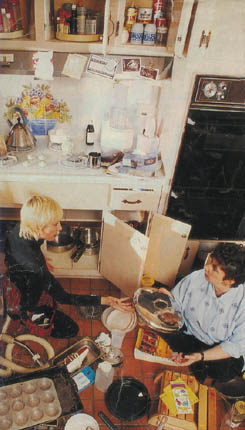
It has to get worse before it gets better.
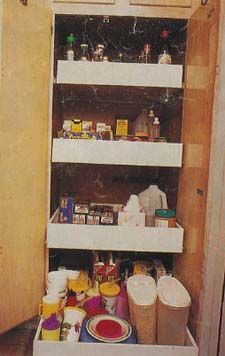
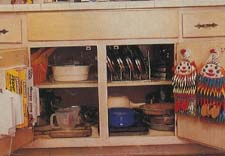
Above: Order in the cabinet under the stove. Potholders and wrap-and-bag rack hang on doors. To save space, pots are nested and large lids stand upright in a rack. Miscellaneous plastic containers are stacked one inside the other, with tops stored neatly in a bag.
THE DIAGNOSIS
After one look at the countertops and a few minutes poking around the cabinets and drawers, Linda knew why Martha was unhappy with the kitchen and unable to keep on top of things. She had committed three of the cardinal sins of organizing:
- There were too many things that were never used.
- Necessities were in inconvenient places.
- Similar items hadn’t been grouped together.
THE CURE
Martha blanched when Linda announced that they were going to start on one side of the room and work around it, taking everything out of each cabinet and drawer and putting it on the floor, “It has to get worse before it gets better,” Linda said, laughing, and they got down to work. As they emptied, they sorted. Items to be thrown out, moved to another room, repaired or given away were put in appropriate bags and boxes on the spot. (“Never leave the kitchen to throw things out or move them. You’ll lose your momentum,” says Linda.)
Everything that was to remain in the kitchen was grouped according to type (plates and utensils, baking pans, canned foods, beverages and so on). Then the two women began to refill cabinets and drawers with a simple plan in mind: Keep things as close as possible to where they are used. Pots, pans and potholders went under the cooktops, spices went above it. Dishes were put in the cabinet above the dishwasher; and mugs, filters and coffee were placed near the coffee machine.
Within each category, things used most often were put where they could be easily reached – on lower shelves and close to the front. “It was all so simple, but I hadn’t caught on,” recalls Martha. “Just a matter of figuring out what you actually do in a kitchen and planning accordingly. When we first moved in I had tons of space, so I just put stuff away haphazardly. I guess the more room you have, the more you fill…or waste.”
FURTHER TREATEMENT
Linda also transformed the junk drawer by paring down (“one roll of tape and one pair of scissors are enough”) and moving tools, sewing supplies and other noncooking miscellany out of the kitchen. She then put a compartmentalized insert in the drawer to keep what was left from turning into a hodgepodge.
Once the family’s dumping ground, the pullout pantry shelves, were restocked so that the bottom drawer held cereal, crackers, plastic plates and everything else the children needed to help themselves to a snack. Oils, vinegars and other bottled seasonings were assigned to the top drawer, canned goods to the one below, and flour, sugar, pasta, rice and other grains went into the one below that.
To maximize work space and tidy up, the countertops were cleared of all appliances except the coffeemaker, which is used daily.
Cookbooks were moved to a shelf across the kitchen, and Linda put most of the cooking utensils into a drawer, leaving only the most essential ones in the countertop pitchers.
The refrigerator was stripped of taped-up notes, clippings and photos. Linda suggested snapshots in frames with magnetized backs for a neater look. She then put up a weekly calendar for monitoring family schedules.
Linda solved the paper problem by recommending that Martha keep bills, stamps, pens, calculator and checkbook in a large basket, creating a portable desk that she could store in her upstairs office and bring to the kitchen when she preferred to work there. Clipped recipes were put in a category file (chicken, desserts, salsas, and so forth) and placed – like the folder with the take-out menus – near Martha’s cookbooks. Linda’s suggestions that she make a master grocery list of things needed all the time, organized by store and aisle, was a hit with Martha. After running off a lot of copies, she could post one each week and check off what was needed as she ran out “No need to keep writing down the same stuff over and over, and it speeds things up when I get to the store.”
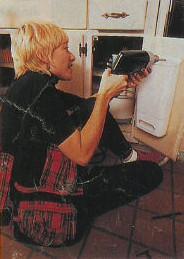
Free drawer space by putting things on cabinet doors, Here, Linda installs a bag caddy.
CHECKUPS
Martha is thrilled with the results of her slightly grueling workday. “I can unload the dishwasher or put away groceries in minutes. Some nights I cook dinner without taking a step!” But will it stay that way, she wonders. Linda is reassuring; “Once you’re organized you have a good chance of staying that way because everyone knows where things go.” Just remember, never put something new in any old place because you’re in a hurry to get it out of sight. Create a holding area and give yourself time to think about where the item should go.”

